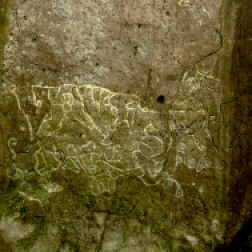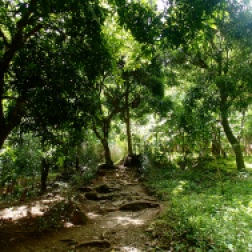I recently had the opportunity to join an EcoCircuitos day tour to El Valle de Anton. El Valle, as the locals simply call it, lies in the crater of a former volcano (while it is officially classified as “dormant” it has not been active for several thousand years), and enjoys the wonderful combination of a refreshing climate and incredibly fertile soil. The valley is indeed a green paradise, full of flowers, trees and flourishing gardens. The picturesque little town is a place where children ride bicycles along the roads and little restaurants offer shady patios overgrown with vines. The famous town market, which nowadays sells souvenirs as well as the original selection of colorful fruit and vegetables, is the place to admire the area’s agricultural bounty.
But we had come for something else; we were headed for a hill right behind the town, to get a glimpse of an ancient mystery: The petroglyphs of the pre-Columbian inhabitants of the valley.
At the beginning of the path we met with a local guide, sixteen year old Tony, who told us he had been guiding visitors to the painted rocks since he was eight, and claimed to know the story of the stones better than anyone else in the village.
It was just a short climb until we saw the overhanging rock looming up before us, carved with intricate lines and symbols. It appears that scientists nowadays do not know enough about the people who made these carvings to be sure what they meant to say, but it is generally accepted that this particular rock displays a map of the area, which was created around the time the first Spanish explorers arrived on the shores of Panama.
Anthony turned out to know this map as well as he had claimed to: whith perfect confidence, he picked out various mountains in the area, waterfalls, and explained a number of the other symbols on the rock. Some were astonishingly clear, one was a very clear picture of a person holding a spear or arrow, some others appeared more mysterious. “Some of these are keys,” explained Anthony, “they open the secret caves of the Indians, but nobody knows where they are anymore.”
The last thing he showed us was one feature of the map that represented a second painted stone, further up the mountain. We left Anthony to turn back then, and continued up the mountain, through the forest, in search of the second rock, the “stone of the toads”.
It was a nice hike, the incline was rather steep, the path rocky, but the breeze was cool and the forest full of birds and flowers. We passed a waterfall, startled a few butterflies, and then, around a bend, we found it: A flat rock on the ground just above a deep gorge, carved with intricate designs. Now without our petroglyph expert, we could only wonder what this rock was trying to tell us, but we could easily enough pick out some animal images: Lizards, or maybe frogs, so clear it was hard to imagine that they had been there for over 500 years…
We continued up the mountain then, speculating about who might have been the people who carved these rocks, enjoying the climb and the lush nature around us and got rewarded with a sweeping view of the valley and its surrounding mountains.
By Meret Schueschke
If you would like to visit El Valle and the Petroglyphs, find more information on our homepage or email us at info@ecocircuitos.com







